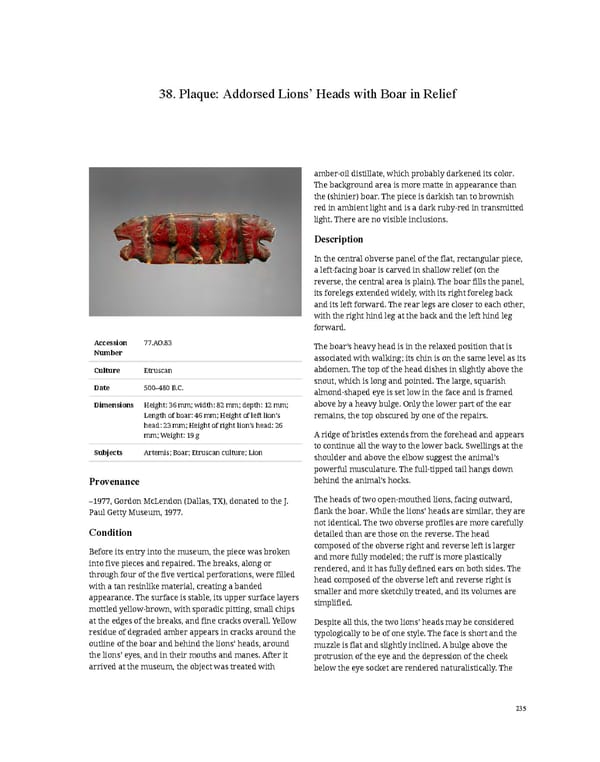38. Plaque: Addorsed Lions’ Heads with Boar in Relief amber-oil distillate, which probably darkened its color. The background area is more matte in appearance than the (shinier) boar. The piece is darkish tan to brownish red in ambient light and is a dark ruby-red in transmitted light. There are no visible inclusions. Description In the central obverse panel of the flat, rectangular piece, a left-facing boar is carved in shallow relief (on the reverse, the central area is plain). The boar fills the panel, its forelegs extended widely, with its right foreleg back and its left forward. The rear legs are closer to each other, with the right hind leg at the back and the left hind leg forward. Accession 77.AO.83 The boar’s heavy head is in the relaxed position that is Number associated with walking; its chin is on the same level as its Culture Etruscan abdomen. The top of the head dishes in slightly above the Date 500–480 B.C. snout, which is long and pointed. The large, squarish almond-shaped eye is set low in the face and is framed Dimensions Height: 36 mm; width: 82 mm; depth: 12 mm; above by a heavy bulge. Only the lower part of the ear Length of boar: 46 mm; Height of left lion’s remains, the top obscured by one of the repairs. head: 23 mm; Height of right lion’s head: 26 mm; Weight: 19 g A ridge of bristles extends from the forehead and appears Subjects Artemis; Boar; Etruscan culture; Lion to continue all the way to the lower back. Swellings at the shoulder and above the elbow suggest the animal’s powerful musculature. The full-tipped tail hangs down Provenance behind the animal’s hocks. –1977, Gordon McLendon (Dallas, TX), donated to the J. The heads of two open-mouthed lions, facing outward, Paul Getty Museum, 1977. flank the boar. While the lions’ heads are similar, they are Condition not identical. The two obverse profiles are more carefully detailed than are those on the reverse. The head Before its entry into the museum, the piece was broken composed of the obverse right and reverse left is larger into five pieces and repaired. The breaks, along or and more fully modeled; the ruff is more plastically through four of the five vertical perforations, were filled rendered, and it has fully defined ears on both sides. The with a tan resinlike material, creating a banded head composed of the obverse left and reverse right is appearance. The surface is stable, its upper surface layers smaller and more sketchily treated, and its volumes are mottled yellow-brown, with sporadic pitting, small chips simplified. at the edges of the breaks, and fine cracks overall. Yellow Despite all this, the two lions’ heads may be considered residue of degraded amber appears in cracks around the typologically to be of one style. The face is short and the outline of the boar and behind the lions’ heads, around muzzle is flat and slightly inclined. A bulge above the the lions’ eyes, and in their mouths and manes. After it protrusion of the eye and the depression of the cheek arrived at the museum, the object was treated with below the eye socket are rendered naturalistically. The 235
 Ancient Carved Ambers in the J. Paul Getty Museum Page 244 Page 246
Ancient Carved Ambers in the J. Paul Getty Museum Page 244 Page 246